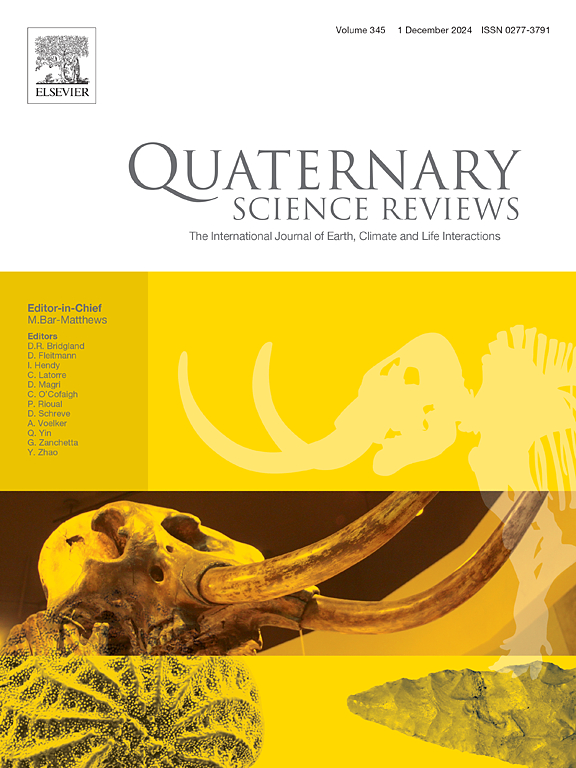Holocene hydroclimate and landscape changes as drivers of organic carbon cycling in a small northern Fennoscandian lake
IF 3.2
1区 地球科学
Q1 GEOGRAPHY, PHYSICAL
引用次数: 0
Abstract
Lakes and ponds play a critical role in the high-latitude carbon cycle. Rapid climate warming, cryosphere degradation and increasing rainfall are transforming catchments and land-water interactions, altering lake carbon cycling in unprecedented ways. Here, we present Holocene (past 10.5 ka) sediment records from a small northern Fennoscandian lake to elucidate linkages of past hydroclimate change and lake carbon cycling. Using elemental and stable isotope composition of organic matter (C%, N%, δ13C, δ15N), age control from 23 radiocarbon dates, and a ground-penetrating radar survey of lake sediment layers, we reconstructed organic matter burial and sources, aided with a Bayesian end-member mixing model based on measurements from modern terrestrial and aquatic vegetation and particulate organic matter. The hydroclimate and lake hydrological regime changes were interpreted from lake-water ẟ18O (ẟ18Olw) reconstructed from subfossil chironomid (Chironomidae; non-biting midges) head capsules and ẟ18O and ẟ2H monitoring of local meteoric, lake and groundwaters. The ẟ18Olw and carbon burial mirror the Holocene temperature pattern, increasing in the cooler early Holocene, at their maxima in the warm mid-Holocene, and decreasing during the late Holocene cooling. The lake was dominated by aquatic organic matter through the Holocene, with benthic sources more dominant in the early Holocene and planktic in the late Holocene. A slight increase in the terrestrial organic matter proportion occurred in the warm and dry mid-Holocene despite reduced hydrological connectivity, which is contrary to the hypothesis that wetter climate increases allochtonous C burial. The higher mid-Holocene ẟ18Olw values were superimposed by lower values at ca. 6.5 cal ka BP, interpreted as increased winter precipitation contributing to snowmelt and isotopically light groundwater impacting ẟ18Olw. This interval is coupled with highly siliceous sediment deposition indicating marked aquatic productivity, possibly linked with inputs of groundwater rich in silica and phosphorous. Our findings underscore the importance of hydrological connectivity on both burial and sourcing of C in high-latitude lakes, and suggest that in future wetter climate, high-latitude lakes may play more important role as processors than sinks of carbon.
芬诺斯坎德北部一个小湖泊全新世水文气候和景观变化驱动有机碳循环
湖泊和池塘在高纬度的碳循环中起着关键作用。气候迅速变暖、冰冻圈退化和降雨量增加正在改变集水区和陆地-水相互作用,以前所未有的方式改变湖泊碳循环。本文利用芬诺斯坎德北部一个小湖泊的全新世(10.5 ka)沉积物记录来阐明过去水文气候变化与湖泊碳循环的联系。利用有机质元素和稳定同位素组成(C%, N%, δ13C, δ15N), 23个放射性碳测年的年龄控制,以及对湖泊沉积物层的探地雷达调查,我们重建了有机质埋藏和来源,并借助基于现代陆生和水生植被和颗粒有机质测量的贝叶斯端元混合模型。用亚化石水摇蝇(Chironomidae)重建的湖水ẟ18O (ẟ18Olw)解释了水文气候和湖泊水文状况的变化;不咬人的蠓)头部胶囊以及ẟ18O和ẟ2H监测当地的大气、湖泊和地下水。ẟ18Olw和碳埋藏反映了全新世的温度模式,在较冷的全新世早期升高,在较暖的全新世中期达到最大值,在较冷的全新世晚期下降。全新世以来,湖泊以水生有机质为主,全新世早期以底栖生物为主,晚全新世以浮游生物为主。在温暖干燥的中全新世,尽管水文连通性降低,但陆相有机质比例略有增加,这与湿润气候增加异质碳埋藏的假设相反。在约6.5 cal ka BP处,较高的中全新世ẟ18Olw值与较低的值叠加,解释为冬季降水增加导致融雪和同位素轻地下水影响ẟ18Olw。这个区间与高硅质沉积物沉积相结合,表明水生生产力显著,可能与富含二氧化硅和磷的地下水输入有关。我们的研究结果强调了水文连通性对高纬度湖泊中碳埋藏和来源的重要性,并表明在未来更湿润的气候中,高纬度湖泊可能扮演更重要的碳处理者而不是碳汇的角色。
本文章由计算机程序翻译,如有差异,请以英文原文为准。
求助全文
约1分钟内获得全文
求助全文
来源期刊

Quaternary Science Reviews
地学-地球科学综合
CiteScore
7.50
自引率
15.00%
发文量
388
审稿时长
3 months
期刊介绍:
Quaternary Science Reviews caters for all aspects of Quaternary science, and includes, for example, geology, geomorphology, geography, archaeology, soil science, palaeobotany, palaeontology, palaeoclimatology and the full range of applicable dating methods. The dividing line between what constitutes the review paper and one which contains new original data is not easy to establish, so QSR also publishes papers with new data especially if these perform a review function. All the Quaternary sciences are changing rapidly and subject to re-evaluation as the pace of discovery quickens; thus the diverse but comprehensive role of Quaternary Science Reviews keeps readers abreast of the wider issues relating to new developments in the field.
 求助内容:
求助内容: 应助结果提醒方式:
应助结果提醒方式:


